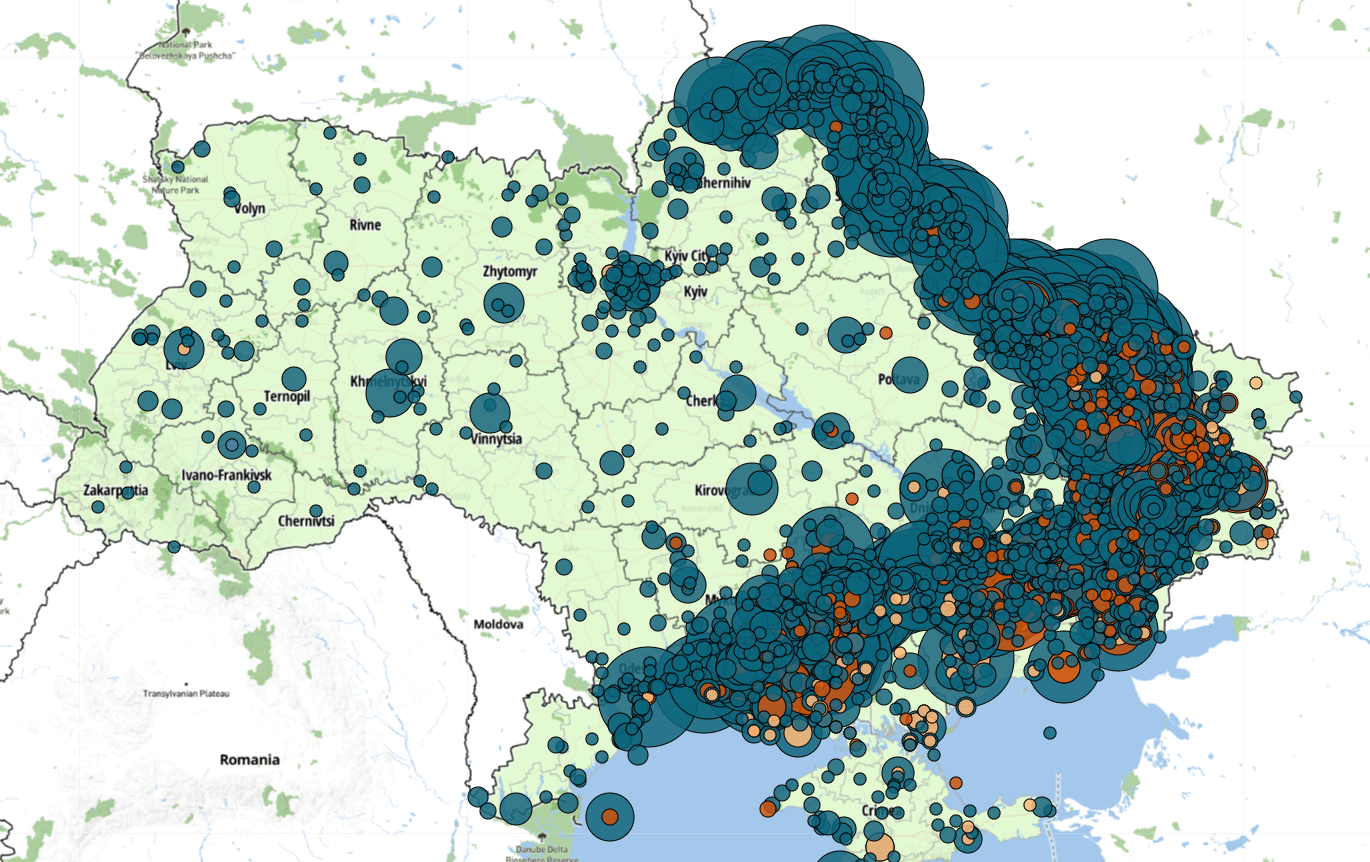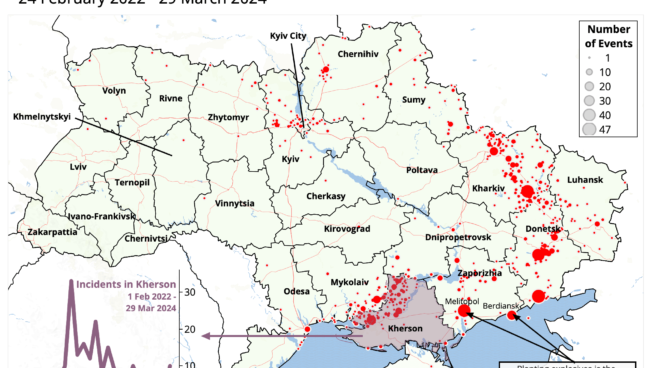Last updated: 5 June 2025
Amid the ongoing war in Ukraine, this aerial photograph shows the destruction in the village of Bohorodychne in the Donetsk region on 27 January 2024. Photo by Roman Pilipey/AFP via Getty Images
ACLED’s Ukraine Conflict Monitor provides near real-time information on the ongoing war, including an interactive map of the latest data from the start of Russia’s invasion, a curated data file, and weekly situation updates. It is designed to help researchers, policymakers, media, and the wider public track key conflict developments in Ukraine. It is released every Wednesday, with data covering events from Saturday to Friday of the preceding week and providing updates to past events as new or better information becomes available.
Ukraine war situation update
24 – 30 May 2025
Key trends
- In the Donetsk region, Russian forces seized three settlements near Pokrovsk and two others south of Kostiantynivka. They also continued advancing north of Velyka Novosilka.
- In the border areas of the Sumy and Kharkiv regions, Russian forces captured two and one settlements, respectively.
- ACLED records at least 42 Russian long-range missile and drone strikes, including in Kyiv city and the Kyiv region, as well as in the western regions of Khmelnytskyi, Zhytomyr, and Ternopil.
- Russian shelling, missiles, aerial bombs, and drones killed at least 38 civilians in the Kherson, Sumy, Khmelnytskyi, Kyiv, Zhytomyr, Donetsk, Mykolaiv, Kharkiv, and Zaporizhia regions. Ukrainian shelling and drone strikes reportedly killed three civilians in the Russian-occupied parts of the Kherson and Kharkiv regions.
Key events
- 25 May | Kyiv – Ukraine and Russia complete a swap of 1,000 prisoners of war each
- 25 May | Khmelnytskyi – Russian drones and missiles kill five civilians and wound five others in Krasyliv
- 29 May | Khmelnytskyi – More than 100 people clash with conscription officers and police in Kamianets-Podilskyi
Spotlight: Russian forces launch a record number of drones at Ukraine
Between the evening of 23 May and early on 26 May, Russia launched the largest wave of drone strikes in Ukraine since the beginning of the invasion in early 2022. According to Ukrainian authorities, Russian forces launched over 900 Shahed-type attack and decoy drones,1Yuriy Svyrydyuk, “‘Iskanders’ and ‘Shaheds’: the Air Force told about the massive attack of the Russian Federation,” Suspilne, 24 May 2025 (Ukrainian); Roman Petrenko, “Russia launches nearly 300 drones and 70 missiles overnight, with hits recorded at 22 locations,” Ukrainska Pravda, 25 May 2025; Valentyna Romanenko, “Another record drone attack by Russia: Ukrainian air defence neutralised 288 UAVs and destroyed 9 cruise missiles,” Ukrainska Pravda, 26 May 2025 damaging civilian infrastructure and killing and injuring civilians across 16 regions, including the western regions of Chernivtsi, Ivano-Frankivsk, and Khmelnytskyi. In Kyiv, Russian drones and ballistic missiles hit apartment buildings and private houses in five of the city’s 10 boroughs, injuring seven civilians. Combined drone, ballistic missile, and cruise missile attacks on 25 and 26 May killed at least four and injured about 28 civilians, while also damaging at least 51 houses in the surrounding region. Accompanying strikes also killed three civilians in the Zhytomyr region and another five in the Khmelnytskyi region, where strikes destroyed almost 40 houses in one town alone. Intensifying and indiscriminate attacks on Ukrainian civilians continued unabated amid Moscow’s refusal to make compromises in the Turkey-mediated peace talks2Vladimir Soldatkin, Tom Balmforth, and Huseyin Hayatsever, “Russia sets out punitive terms at peace talks with Ukraine,” Reuters, 3 June 2025 and its grinding occupation of eastern Ukraine.
Explore the ACLED Conflict Exposure tool to assess the numbers of people affected by armed violence, disaggregated by locations, time period, and actors involved.
Ukraine Conflict: Interactive Map
This interactive map includes political violence events in Ukraine since the start of the Russian invasion on 24 February 2022.
Date and subset filters
By default, the map displays data for the most recent week. Use the date filters to change the date range in view.
Use the subset filters to analyze trends in more detail.
Changing view
By default, the map is set to event view, which uses scaled circles to show events at a given location. Click on a region in Ukraine to zoom in for a more detailed view. Hovering over a region will give a count of events within its borders.
Changing to region (oblast) view will switch the map to a choropleth, giving an overview of event density per region. This will also disable the zoom function.
Events in Russia
While in event view, use the ‘Events in Russia’ toggle to show or hide conflict-related events in Russia. Conflict-related events are identified as follows:
- All events with the ‘Battles’ or ‘Explosions/remote violence’ event type.
- Events with the ‘Violence against civilians’ event type, where the actor is:
- Ukrainian or Russian military
- Russian border guards
- Pro-Ukrainian Russian militias
Attacks on Ukranian infrastructure
ACLED uses four automatically generated infrastructure tags when coding events that occur in Ukraine, each covering a vital sector that focuses on civilian infrastructure: energy, health, education, and residential infrastructure.
For more information, read our methodology explainer.
Event counts and civilian fatalities
The box in the bottom right hand corner displays event counts in total, disaggregated by event type, and filtered by date or subset according to the options already selected.
It also shows a conservative estimate of civilian fatalities, limited to events where civilians are targeted directly. Military casualties are not represented on the map as they are largely unverifiable.
For more information on how ACLED codes fatalities, read our methodology explainer.
Curated Data
This file contains all political violence events, demonstration events, and strategic developments recorded in Ukraine and the Black Sea from the beginning of ACLED coverage in 2018 to the present.
For an overview, see our interactive dashboard.

Ukraine & the Black Sea ( 30 May 2025 )
Attacks on Ukranian infrastructure
ACLED uses four automatically generated infrastructure tags when coding events that occur in Ukraine, each covering a vital sector that focuses on civilian infrastructure: energy, health, education, and residential infrastructure. This file contains all events featuring one or more of these tags.
For more information, read our methodology note.
Sign up for Ukraine Conflict Monitor updates
Information & Analysis
For additional information on the conflict in Ukraine, check our analysis of political violence trends from the start of ACLED coverage in 2018.












